IDERA ER/Studio Data Architect Professional
Data Modeling Software for the Enterprise
A Full Suite of Database Tools for
Data Architecture Professionals
Working in a Team
Everything you need for big data modeling, all in a single user-friendly interface
Data modelers and architects are tasked with the mission-critical task of taking requirements for data assets and translating those into implementable designs. This has to be with control and within a data governance framework. Whether you are creating a new model from a conceptual model or modifying an existing asset by making changes to reverse-engineered model, user-friendly data architecture and design tools make the following tasks quicker, easier, more accurate, and more collaborative:

- Building out an enterprise data model as entity relationship diagrams (ERD)
- Discovering and documenting your existing data assets
- Designing database schema, starting from logical data models through to linked physical data models
- Laying the foundation for robust data governance and data management
-
Extensive Database Platform Support
Access and manage models for multiple relational and big data platforms, both on premises and in the cloud. Extensive platform support is enabled through native and database-specific ODBC connections.
-
Forward and Reverse Engineering
Generate physical data models from existing database designs. Construct graphical models from existing database or schema, for both relational and big data platforms. Easily apply design changes with formulated alter code.
-
Universal Mappings
Map between and within conceptual, logical and physical model objects to trace objects upstream or downstream, using the repository, and specify metadata such as definitions, notes, and attachments.
-
Data Dictionary Standardization
Define and enforce standard data elements, naming standards and reference values for use across and between data models.
-
Advanced Compare and Merge
Enable advanced, bidirectional comparisons and merges of model and database structures.
-
Business Data Objects
Represent master data and transactional concepts with multiple entities and relationships, such as products, customers, and vendors.
-
Submodel Management
Allow creation of multi-leveled submodels, merge submodel properties across existing models and synchronize submodel hierarchies.
-
Naming Standards
Assign a naming standards template to models, submodels, entities and attributes for automatic application between logical and physical models.
-
Automatic Migration of Foreign Keys
Maintain foreign keys to ensure referential integrity in database designs.
-
”Where Used” Analysis
Display mappings between logical entities and attributes to their implementation across physical designs.
-
Model Completion Validation
Automate model reviews and enforce high-quality data standards by validating for missing object definitions, unused domains, identical indexes and circular relationships.
-
Visual Data Lineage
Visually document source/target mapping and sourcing rules using a drag-and-drop interface to understand Extraction, Transformation, and Load (ETL) data movement across systems.
-
Source-to-Target Mapping
View the relationships between the source and target, how the data flows from one table to another, and how the data is transformed.
-
Dimensional Modeling
Leverage complex star and snowflake schema designs and support importing rich dimensional metadata from BI and data warehouse platforms.
-
Metadata Integration
Import and export metadata from BI Platforms, UML and data modeling solutions, XML Schemas and CWM (Common Warehouse Metamodel) to create a metadata hub.
-
Data Classification
Categorize and label objects according to the level of security and privacy.
-
Permission Management
Enable user, role and group permissions at the logical and physical level.
-
Security Attributes
Define data security types and properties to be observed and enforced for compliance.
-
Security Center Groups
Streamline security administration with local or LDAP groups, improving productivity and reducing errors.
-
Concurrent Model and Object Access
Allows real-time collaboration between modelers working on data models down to the model object level with token-based check-in/check-out.
-
Version Management
Manages the individual histories of models and model objects to ensure incremental comparison between, and rollback to, desired diagrams.
-
Component Sharing and Reuse
Predefined Enterprise Data Dictionary eliminates data redundancy and enforces data element standards.
-
Agile Change Management
Assign and track tasks associated with data models to align changes to user stories and development workflows.
-
Advanced Graphics and Layout
Automatically create highly readable, highly navigable diagrams with one or a combination of layouts.
-
Automated and Custom Transformation
Streamlines the derivation of one or more physical designs from a logical one and checks for normalization and compliance with the target database.
-
Rich Text Editing
Easily edit text in data object fields, with integrated spell-checking, embedded hyperlinks, and text wrapping.
-
Extensible Automation Interface
Automate tedious, routine tasks such as coloring tables, enforcing and applying naming standards, globally update storage parameters and integrate with desktop applications.
-
Multiple Reporting Formats
Publish models and reports in a variety of formats including HTML, RTF, XML Schema, PNG, JPEG and DTD Output.
Let’s get started.
Start your 14-day trial, no credit card required (but all fields are).
Commercial licenses are not supported. To update to the latest version, please access IDERA’s customer support portal.

ER/Studio Data Architect
Datasheet
Everything you need you need to know all in one downloadable PDF.
5 Data Modeling Tips for Better Data Governance
See how data modeling needs to be part of an organization’s portfolio for better data governance processes.

Deliver Data-Driven Capabilities
See how Werner Enterprises harmonized and standardized their understanding of information and data for all business users.

View a Democast
Join a free, live democast to see ER/Studio Data Architect Professional in action.
ER/Studio Data Architect Professional Videos
Learn more about features and related topics in the Resource Center.

Role of Data Architects in Data Governance
See how data governance programs have leveraged data architects and the impact of that involvement.
You can view the list of all resources for ER/Studio Data Architect Professional in
the Resource Center.
Try ER/Studio Data Architect Professional for yourself today with a demo and tutorial, or request a quote to learn more about our pricing.
Frequently-Asked Questions
- Controlled access to data models and projects in a collaborative environment
- Ability to display, access, and reuse common elements across models
- Granular check-out and check-in of diagrams, sub-models, and objects
- Conflict resolution at check-in to eliminate model differences
- Alignment of modeling changes to development tasks and workflows
- Clear and effective change tracking and audit trail for compliance
- Version management for objects and models with named releases
- Secure access to all assets to maintain data model integrity and privacy
ER/Studio Data Architect Professional Product Benefits
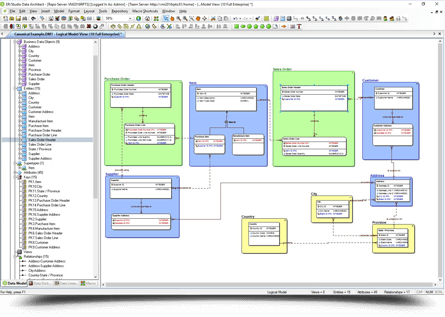
Document, design, and communicate
data assets faster and easier
Round-trip database support gives ER/Studio Data Architect users the power to easily reverse- and forward-engineer, compare and merge, and visually document data assets across multiple relational, NoSQL, and ETL platforms and data sources. Built-in facilities automate routine data modeling tasks so users can analyze and optimize database and data warehouse designs faster than ever.
Group multiple entities aligned
to a specific area into
a Business Data Object
Create Business Data Objects by assigning one or more related entities to a BDO. Then, users can easily view attributes, definitions, or other information about the entities in the objects. These BDOs are then reusable objects that can be used in other submodels within the model. Users can quickly expand or collapse a Business Data Object (BDO) to simplify the model view for different end users and audiences.
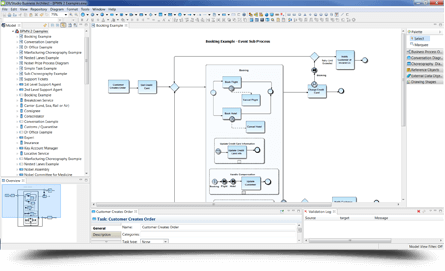
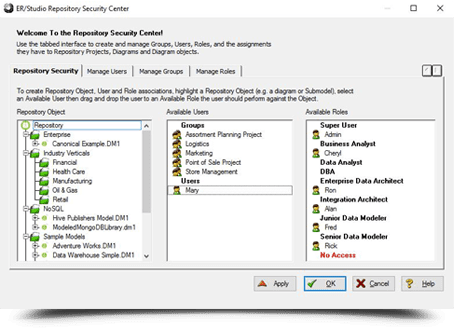
Streamline collaboration on data models in a team environment through a shared repository
The Repository (included with ER/Studio Data Architect Professional) provides a secure and scalable environment for model and object version management and change management. Data modeling teams can check-out and check-in portions of the same model to work collaboratively within the repository, and easily identify which model objects have been checked in using the model explorer tree.
Easily compare differences between
two data models or databases,
and merge changes between them
ER/Studio Data Architect’s Compare and Merge wizard helps you reduce duplication and risk associated with multiple data sources and platforms. Quickly compare data models and databases to identify differences, and determine whether to merge differences to the source or the target. ER/Studio generates the Alter scripts to implement the changes for a database.
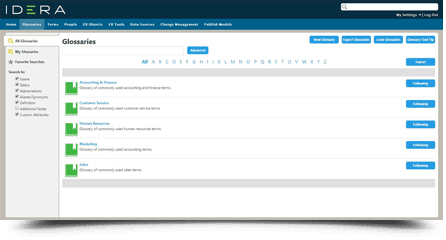
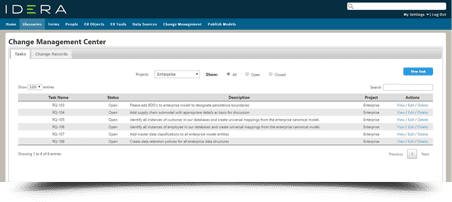
Manage and track model changes
against user stories or tasks
In ER/Studio Data Architect Professional, data modelers can create change records to represent user stories or tasks aligned to the development workflow, and then associate them to models stored in the Repository. Object check-in and check-out within the Repository can be linked to a specific change record stored in the Change Management Center.
Get started with ER/Studio Data Architect Professional today. No credit card required..


